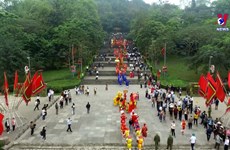Future of Long Bien Bridge open to discussion
Hanoi always emphasises the importance of ensuring the preservation of
Long Bien Bridge in harmony with its socio-economic development,
Chairman of the municipal People’s Committee Nguyen The Thao has
declared.
Hanoi always emphasises the importance of ensuring the preservation of
Long Bien Bridge in harmony with its socio-economic development,
Chairman of the municipal People’s Committee Nguyen The Thao has
declared.
The municipal leader has also affirmed that discussion and suggestions are important to create an optimal plan for the bridge, whose rebuilding plans introduced recently by the Ministry of Transport sparked controversy.
In the coming time, suggestions from scientists, managers and experts will be collected for the plan, focusing on preserving and tapping the cultural and historical values of the bridge in combination with local socio-economic and traffic development and the urban landscape.
In the city’s overall socio-economic development plan approved by the Prime Minister in 2011, there was a project to build a railway bridge over the Red River at the area where Long Bien bridge stands.
The Ministry of Transport had earlier proposed three plans. The first was to install a new bridge exactly where the old one stands, keeping the central part and the railway track intact, and removing other parts of the bridge for preservation.
The second option was to build a new, modern bridge with a similar design to the original, and the third was to modernise the bridge while retaining parts of the central section and trusses.
Long Bien Bridge was built between 1899 and 1902 by the French and measures 2,290m. It opened to traffic in 1903.
At the time, it was the only bridge spanning the Red River that connected Hanoi to the highway leading to the northern port city of Hai Phong. It has played a crucial role in many important events in the country’s history, including the independence wars.
It was heavily bombarded during the American War and became a symbol of defiance against aggression. It is no exaggeration to say that the bridge is an intrinsic, indispensable part of Hanoi’s history and folklore, inspiring poets and musicians for generations.-VNA
The municipal leader has also affirmed that discussion and suggestions are important to create an optimal plan for the bridge, whose rebuilding plans introduced recently by the Ministry of Transport sparked controversy.
In the coming time, suggestions from scientists, managers and experts will be collected for the plan, focusing on preserving and tapping the cultural and historical values of the bridge in combination with local socio-economic and traffic development and the urban landscape.
In the city’s overall socio-economic development plan approved by the Prime Minister in 2011, there was a project to build a railway bridge over the Red River at the area where Long Bien bridge stands.
The Ministry of Transport had earlier proposed three plans. The first was to install a new bridge exactly where the old one stands, keeping the central part and the railway track intact, and removing other parts of the bridge for preservation.
The second option was to build a new, modern bridge with a similar design to the original, and the third was to modernise the bridge while retaining parts of the central section and trusses.
Long Bien Bridge was built between 1899 and 1902 by the French and measures 2,290m. It opened to traffic in 1903.
At the time, it was the only bridge spanning the Red River that connected Hanoi to the highway leading to the northern port city of Hai Phong. It has played a crucial role in many important events in the country’s history, including the independence wars.
It was heavily bombarded during the American War and became a symbol of defiance against aggression. It is no exaggeration to say that the bridge is an intrinsic, indispensable part of Hanoi’s history and folklore, inspiring poets and musicians for generations.-VNA













